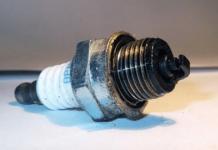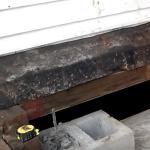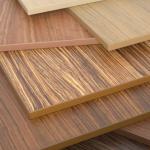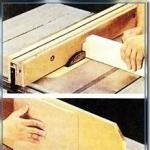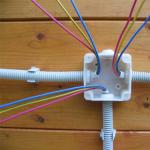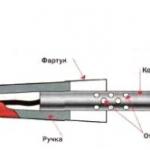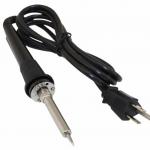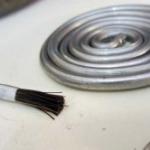An auxiliary ruler and other devices for circulars, which will be discussed below, are needed, for example, in order to hide the groove disk when cutting a fold, to install a clamp in order to press the workpiece more tightly against the circular blade (table), etc.
The ruler consists of three plywood strips with a pair of folds and grooves (Fig. 1), as well as a profile installed in its grooves with a groove for a T-shaped screw (hereinafter T-profile). Installing accessories takes a couple of seconds.
Ruler design
Start making the ruler by making side walls A from 20mm plywood.
The length of the side walls is equal to the length of the standard ruler, and the width (height) is sufficient to provide good support for the workpiece and allow workpieces to pass freely from above.
Grooves and folds.
After sawing the side walls to size, cut a fold on top of each part (Fig. 2) and a groove on the front side of one of them. The groove should be large enough for the T-profile to be flush with the face of the ruler.
Drilling mounting holes.
The next step is to determine the position of the mounting holes for attaching the auxiliary ruler. It is fixed with handles, washers and a pair of embedded bolts. The holes are drilled at the same distance from the ends of the ruler (fig. 3) so that it can be used on either side of the disk. The heads of the embedded bolts must be recessed.
Spacer.
Now connect the side walls with spacer B. It is necessary to clamp the standard ruler between the side walls of the auxiliary ruler, measure the distance between the folds, and then cut out the spacer.
Second groove. A groove for the second T-profile is selected on the spacer. Its size must be determined so that the profile is flush. Regardless of the width of the spacer, the groove is located at a distance of 22 mm from the outer face of the ruler.
Assembly.
Attach the side walls to the spacer with glue and screws.
Then fix the T-profiles in the grooves. On the outer edges of the ruler, chamfer at a 45° angle to avoid chipping the plywood (Fig. 4).
Installation. The auxiliary ruler is fastened with a pair of embedded bolts to avoid its lifting in case of using a clamp. To attach the auxiliary ruler, drill through mounting holes in its side walls. Then insert the captive bolts, put on the washers and tighten the knobs.
Auxiliary planes
Auxiliary planes are parts made of 20 mm plywood, attached to the T-profile in the side wall of the auxiliary ruler with recessed bolts for T-slots with nuts and washers (Fig. 5 and 5a).
The selection on the auxiliary plane C allows you to hide the groove disk when cutting folds. The high D plane provides additional support for wide (high) workpieces.

Rammer
The rammer allows you to keep your hands at a safe distance from the disk when sawing thin parts and ensures that the part is fed until the end of the cut. A distinctive feature of the rammer is a handle that moves in the upper T-shaped profile of the ruler. To pass a thin bar through the disc, the rammer has a heel that can be raised (or lowered) depending on the thickness of the workpiece.

Pen.
The H handle is made from a piece of 20mm hardwood plywood. After sawing out a short spike along the bottom edge under the T-shaped profile (Fig. 6), saw out the handle along the contour and round off the edges.
Frame.
Attach the body F to the handle, consisting of a bar with a groove and a narrow outer bar. A shallow 5mm groove in the main piece is for the heel, while an external bar locks the heel in place with two bolts, washers and wing nuts.
Heel.
The G heel is a replaceable piece made of 6mm MDF with a small tooth on the bottom edge. The tooth rests on the workpiece and feeds it to the saw blade.
CLAMP
Clamp - an integral part of the desktop circular. In addition to firmly pressing the workpiece to the saw table, it also prevents it from kicking back towards the worker.
The clamp consists of two parts - the base for its attachment to the auxiliary ruler and the clamp itself with flexible "fingers" that hold the workpiece (Fig. 7).

Base.
The H base is a 6 mm hardwood rectangle that rests on the top plane of the auxiliary ruler. So that you can work with a clamp on the front side of the groove disk, a short slot is made in the base. Two through holes drilled at the ends of the base are designed for fastening the clamp with embedded bolts, washers and handles.
Clamp.
Since the clamp I works in tough conditions, make it from 12mm hardwood. Mark the grooves, cut them out and clean them. So that during operation the “fingers” clamp the workpiece, saw off the end of the workpiece with them at an angle of 30e. Then file the opposite end at the same angle.
Sawing "fingers".
To make "fingers", you need to cut a series of grooves. To ensure that there is an equal gap between them, make a special device.
limiter
The last device - the limiter - allows you to file many small parts of the same length. The L-shaped stopper (fig. 8.) easily locks into place. To avoid trapping the workpiece, the pore provides clearance between the workpiece and the ruler.
The limiter consists of two parts - base J and pillar K. Both parts are made of 20 mm hardwood and are connected with glue and screws.
The hole in the middle of the rack is used to attach the limiter to the T-profile. A small chamfer along the bottom edge of the base provides clearance for sawdust to escape.

Fixture 1
Slots in the clamp can be cut quickly and easily using the tool shown in fig. 9. It has two slots at a distance of 3 mm from each other: an insert is glued into one, and a saw blade enters into the other. Note. The saw blade should be tilted at an angle of 30 degrees.
To cut the first slot in the clamp, attach the part to the backing board so that it is firmly pressed against the insert (Fig. 9a). Make the first pass. After sawing the first slot, unfasten the part and put it on the insert. Then fasten the part again and make a second pass. Repeat this operation until you cut out all the "fingers" on the clamp.
Fixture 2
The auxiliary ruler to the T-shaped longitudinal ruler of the circular (Fig. 10) is almost the same as the ruler described above. All parts are the same size, except for the L insert, which is wider. On the new ruler, the groove for the T-profile should be at the same distance (22 mm) from its front side.
This idea was proposed to us by Vasily Art from Shchelkovo.
I would like to tell you about the guide for a circular saw. Not so long ago I worked for (installation of sliding wardrobes, the tool of a former partner), and I really liked it. But there is no money to buy the same for oneself, and it is not expected in the foreseeable future. The most budgetary Elitech with a guide costs about 12k. The guides themselves cost from 3,000 rubles separately. Which is also expensive. Rummaging through the expanses of the Internet, I did not find anything intelligible and began to think .... And then do
In general, I submit the idea to your judgment. So, we need
- Aluminum strip 1200 * 300 - a little less than 1k.
- Aluminum corner 10*10*1000 - 51r - 2 pcs.
- Bar 10 * 10 * 2000 - also about 100 rubles - 1 pc.
- Plywood 10mm - I don't know about 500*500))
In the photo, in my opinion, everything is clear. If you have any questions, I'll try to explain.
First of all, we make a guide. We glue a glazing bead into the aluminum corner, which we then grind into a plane. We, in turn, fix it on an aluminum plate. For additional strength, it is desirable to strengthen the connection with self-tapping screws.
Leave more space on the tire on the left, I shrugged it off, but it turned out that the rigidity was not sufficient, nothing could be screwed on. I'll rack my brains on how to do it.
Ideally, leave 30 mm from the motor so that you can put clamps, but this is ideal. The guide is ready. 
We turn to the refinement of the sole of a simple circular. The essence of the refinement is the manufacture of a triangular groove. To do this, we take two pieces of plywood, saw them down at an angle of 45 degrees, and glue / screw another piece of aluminum corner into this corner. It is desirable to do this on the tire, at the beginning on the glue. so that there was a plane and the saw did not drive.  Then, in the new sole, we make a cut under the disc. First, we simply immerse the disk in it in the on state until the riving knife rests.
Then, in the new sole, we make a cut under the disc. First, we simply immerse the disk in it in the on state until the riving knife rests. 
Under the knife will have to be done with a jigsaw.  Anterior to the disk, it is also desirable to extend the cut for dust removal, otherwise, it simply will not be.
Anterior to the disk, it is also desirable to extend the cut for dust removal, otherwise, it simply will not be.  Tests have shown that the idea is quite working. The cost of such a device was only 1500 rubles.
Tests have shown that the idea is quite working. The cost of such a device was only 1500 rubles.
Before you start making a circular saw with your own hands using a hand-held circular saw, you need to know the basic rules for working safely on it.
Scheme of the drawing of sharpening and wiring of the saw - 1) Saw blade. 2) Sharpened tooth. 4) Device for sharpening. 5) desktop for saw sharpening. 6-7-8) Directions of the file, relation to the working table and saw teeth to be sharpened. 9) - The line of bending of the teeth during divorce.
The work associated with sawing timber with this tool requires maximum attention. When fixing a powerful hand-held circular saw permanently on the table, you must remember this and install all the required protective equipment on the frames. The saw blade must necessarily have a protective cover, on the table - a parallel stop.
Applications of circulating hand saws
The manual circular electric saw belongs to the category of hand tools.
The initial characteristic of a circular saw is the cutting depth, which for different models can vary from 30 to 130 mm.

The required power and diameters of the saw blades depend on this parameter. According to the depth of cut, the tool is usually divided into categories:
- Up to 45 mm - power from 0.8-1.2 kW, disc diameter 130-160 mm;
- Up to 60 mm - power about 1.8 kW, disk diameter up to 200 mm;
- More than 60 mm - power more than 2 kW, disc diameter up to 350 mm.
When purchasing a saw, it is advisable to ask about its capabilities. For example, is it possible to move the disk in a vertical plane, which allows you to start cutting the material without necessarily from the edge. It is good if there is an adjustment of the rotation speed and a quick braking of the disk after the tool is turned off. Important for the home electrical network is the smooth start-up, which significantly reduces the inrush current in the network.

Figure 1. Electric saw - this type of saw is well suited for woodworking.
A powerful hand-held circular saw can be attached to the bottom of the table and used as a stationary sawmill with a limited cutting depth. Stationary sawmills necessarily have a guide with which you can cut, for example, boards, so that its longitudinal edges are parallel and the angles in cross section are straight.
It is inconvenient to cut large sheets even on a stationary sawmill alone. Such a problem arises in the independent manufacture of furniture, when it is necessary to cut plywood or other material in the form of large sheets. When using a manual circular saw in the usual version, it is impossible to cut the sheet evenly along the entire length and with perpendicular edges.
Therefore, when buying a manual circular saw, the master also acquires a special device for it, which is a guide rail (guide ruler), which allows you to cut the sheet evenly along the entire length. Image 1 shows one of the ruler options.
Back to index
The influence of the design features of the saw
The guide bar for the saw is produced by the same manufacturer, so it is not universal, that is, it is suitable only for a specific tool, while having a high cost. It will be much cheaper to make the same device on your own. However, with the apparent simplicity of the guide rail, it is not easy to make such a part for a saw with your own hands.
The design of such a device depends on the profile of the base of the power tool. Image 1 shows a guide bar for a circular saw, which is made of a non-standard profile, so it is only suitable for a specific brand of product.

Figure 2. Circular saw - this saw has the name circular saw.
Completing the saw with a guide suitable only for it, the manufacturer provides a special place in the profile for clamps, with which it can be fixed on the sheet material being cut so that it does not interfere with sawing at the beginning and at the end.
It is the fastening unit that causes certain difficulties in the independent manufacture of the guide. Therefore, it is very important to determine in advance the type of clamp suitable for securing the workpiece.
Image 2 shows a circular saw that has a small distance from the bottom of the platform to the engine when the saw blade is at zero position. This significantly limits the size of a self-made guide ruler in height. With such a height of the ruler, there will be problems with ensuring rigidity when it is fixed. With an increase in the rigidity of the guide line, the depth of cut of the workpiece decreases, since you will have to work with a non-zero position of the saw blade.
Back to index
Ruler guide for a circular saw, manufacturing
The simplest version of the guide for cutting large sheets is shown in image 3.
A sheet of plywood with factory edges that are even in length, which is prepared for self-manufacturing of a cabinet cabinet, can be used to make a guide rail. To do this, it is necessary to cut off a strip from it with a width equal to the maximum width of the circular saw in the plan, plus 20 cm. The length, L, of this sheet should be slightly larger than the maximum length of the material from which the furniture is planned to be made.

Figure 3. Guide rail for a circular saw - it can be made from improvised means by filing a flat sheet of chipboard or OSB.
Stepping back from the factory edge (we believe that it fits perfectly flat) on a cut piece of plywood 5-7 cm, cut off a strip. This will be the ruler along which the bed of the hand-held circular saw should move. The rest of the cut piece of plywood will serve as the base on which the ruler will be fixed. Along the ruler, leaning on it, move the saw during cutting.
It is very important that the height of the ruler be at least equal to the thickness of the saw bed, but not more than the distance to the engine.
Now you need to fix the ruler on the base. Fix at a distance of 10 cm from the edge or less, but sufficient for the use of clamps.
A very important point of fixing: the factory edge should be directed to the side where the cutting will be carried out. The guide is glued to the base and additionally fixed with screws.
The final stage of manufacturing is the removal of the excess part of the base. This is done using the same saw for which this entire structure was built. The removal process is shown in image 4. The resulting edge on the base will be the same even along the entire length as the factory edge of the plywood on the ruler.
Usually a manual circular saw is one of the first acquisitions of a home craftsman. This versatile tool is truly indispensable for both building a house and making furniture. But if you spend an extra half an hour making simple guides for a hand-held circular saw, then it will be easier and more convenient to work.Stop for cross cuts
This is one of the simplest and most commonly used fixtures that allows you to quickly and accurately cut long workpieces at an angle of 90° or 45°. The base of the stop is made of textolite 3-5 mm thick or plywood 8-10 mm thick. Support bars with a section of 20x20 mm can be beech or oak. The bars are connected to the base with countersunk screws. It is important to accurately maintain the angles of 90° and 45° between the support bars. If necessary, similar stops can be made for other cutting angles.
"Saddle" for cutting beams
For cutting a large number of identical bars, it makes sense to make a special U-shaped device. It is pressed against the bar to be cut as a "saddle". "Emphasis-saddle" consists of three parts: a back and two sidewalls. The back is a piece of board with a thickness of 20-25 mm and a width equal to the cross section of the timber. Sidewalls are made of textolite (3-5 mm) or plywood (8-10 mm). The width of the sidewalls must be such as to support the edge of the saw table before the saw blade enters the timber of the cant.
Without removing the stop, you can accurately cut a thick beam in two passes - on one side and on the other.

Edge stop
To make this emphasis, it will take considerable time and accuracy. But due to the greater length of the supporting edge a homemade guide will provide a smoother cut than the guides that are equipped with saws. The base of the stop and the support bar are cut out of plywood 12-15 mm thick. At the base, grooves are selected for the guide keys, and a hole is made for the saw blade and a through groove for the clamping screw. Hardwood (beech, oak) is used for the manufacture of the edge of the support bar, dowels, saw mounting rails. The adhesive joints of the dowels (in the groove) and the edge with the support bar, as well as the saw mounting rails with the base, can be reinforced with small countersunk screws.
For the convenience of setting the cutting width, it is advisable to stick a piece of tape from an old tape measure along the through groove along the front surface of the stop base.
In order to avoid damage to the working surface of the workbench, a piece of board is placed under the workpiece to be processed.

Blank as a template
When cutting a large number of identical parts, the first cut part can be used as a template. To do this, it is necessary to screw a bar to its end as a stop, in width equal to the distance from the edge of the base plate of the saw to the saw blade. With such a device, you will cut off the required number of blanks - the same length, without wasting time marking each one.

Device for cutting sheet material
The simplest device with a guide rail-tire allows you to quickly and accurately cut sheet material.This device will help with cutting wide sheet materials: plywood, chipboard, blockboard. Its basis is a strip of plywood 6-8 mm thick with a guide rail-tire. The length of the strip should be slightly greater than the width of the sheet to be cut. The rail can be glued to the base or attached with countersunk screws. The narrow edge of the base (to the left of the rail) is used for pressing with clamps, the wide edge (formed during the first cut) is used to align with the marking line on the workpiece.
- Thrust ruler
- Materials and Assembly
- Remote guide
- rail miter box
The guide rail for a circular saw is a device that provides a smooth cut. In total, there are two ways to help make a straight cut:
- Rigid fixation of the electric saw on the desktop.
- Stationary clamping of the workpiece, installation of a guide rail for manual circulars.
The first option involves fixing the tool on the workbench, while the workpiece moves along the guide. The quality of the cut will be high, but the dimensions of the workpiece are limited, due to the size of the machine. With the second processing method, the parameters of the workpiece can be arbitrary. The main thing is that the trimming tool is securely fixed.
Carpentry device manufacturers produce a wide range of guide rails for circular saws. Details are convenient to use, meet safety regulations. The design drawing includes a guide ruler. In some cases, it is possible to set the required degree of inclination of the cutter, it is possible to avoid backlash, jamming of the working element during its movement.
The factory carriage mounted on the circular does the job well, but is expensive. The article describes how to assemble a saw guide bar on your own.
Thrust ruler
Self-manufacturing of devices for circulars requires strict adherence to safety rules.
The cutting stop is often used when processing the material of a circular saw; it is effective only in the case of a jigsaw; problems can arise with cutting: the tire is pressed against the workpiece with a clamp.
The bracket protrudes from the bottom and top sides of the machine tabletop. The result is a limiter for the length of the cut, but the saw motor inevitably rests on the clamp, the cut is performed in two stages. The quality of the edge will be poor, there is a high probability of an unwanted step: to ensure a perfect cut, a continuous movement of the cutting blade from the beginning to the end of the lumber is necessary. In factory models, the fastener is taken out of the range for a circular saw, does not interfere with work.
Materials and Assembly
A homemade guide rail can be assembled from an aluminum plaster rule. The device has a complex configuration, on the one hand it is equipped with a longitudinal groove for setting the handles in a comfortable position. Hidden clamps can be made from quick-release screwless clamps.
The paw must be dismantled from the clamp, fluoroplastic or polypropylene runners should be installed in its place. The material of the moving element must be strong and have a low coefficient of friction. The part is best shaped with a milling cutter or a metal hacksaw with fine teeth, but in the second case, you will have to additionally shape it with a file.
At the next stage, the sliders are installed in the groove of the rule, from which the guide for the manual circular saw will be created.
It is necessary to ensure that the sliding is free, but without play. It is not necessary to apply excessive force: during operation, the knot must be fixed.
Screw the sled to the top of the clamps. In this case, you need to make sure that the connection is strong so that spontaneous unwinding of the knot does not occur during operation. This will damage the workpiece or cause injury.
The guide rail for a circular saw should hold well and not play. The resulting design will allow you to unravel flat lumber, the length corresponding to the same parameter of the ruler minus the margin on the sides of fixing the clamps.
If during the test sawing a perfectly even cut is obtained, nothing interferes with the work, then the technology has been followed, the guide has been made correctly.
Plus design - the line will be inexpensive. Labor costs are also insignificant, they consist only in the formation of sliders.
Remote guide
The device with a guide rail has a disadvantage - the need to control the side contact of the saw with the ruler. If cutting a workpiece that is too wide, the arms may not be long enough to guide the material. The way out is to use a carriage with ball bearings. It won't be cheap, but it will pay off in the long run.
The guide carriage can be made from a corner and metal plates. The width is adjusted using wing locks integrated into the movable grooves. A profile of complex configuration is bought in a specialized department of a hardware store. There may be several options, but you need to provide a parallel stop for the circular.
If for some reason it is not possible to make an auxiliary element from a profile that will guide the cut along a clear line, you can buy an assembled device consisting of a carriage and a guide. The circular will be firmly connected by the sole to the carriage structure.
It is important to achieve strict parallelism of the circular motion along the profile. An improperly set stand will give a loose cut. An external guide rail for a circular saw is easy to make with your own hands. As a result, it will be possible to guide, process large-sized lumber, make high-quality cuts, trimming will be accurate, the saw will carry out easy movements. Feeding can be carried out manually or with the help of a guide rod.
rail miter box
The operation of a circular saw with a guide bar assembled according to the first two methods will be comfortable, but rather slow. To speed up the process, it is better to use a rail miter box. For the manufacture of the guide device will require:
- the same type of metal corners (2 pcs.);
- a sheet of plywood or chipboard with a thickness of 1.5 cm or more (as a base);
- nuts with bolts (4 sets).
The guide angles must be fixed in the same plane at a distance slightly greater than the thickness of the workpiece. The workpiece must move freely under the rails, the cutting wheel must not be too high. The bolts will act as studs. To reduce friction, you can glue strips of fluoroplast, but it is better to equip the fixture with wheels.

A guiding tool made according to this scheme is complex, but its efficiency is higher.
The video shows the assembly process, the functioning of a circular with a guide rail.




